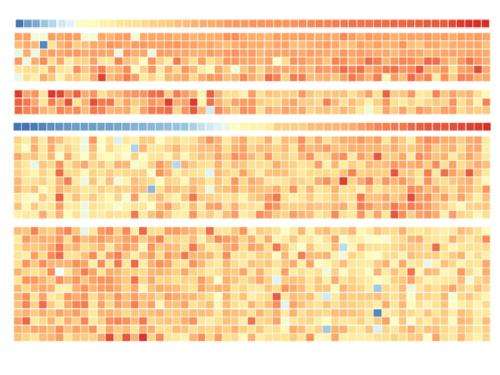Researchers investigate 59 tumor cell lines

In what is the biggest study of its kind to date, researchers from Technische Universität München (TUM) have identified over 10,000 different proteins in cancer cells. "Nearly all anti-tumor drugs are targeted against cellular proteins," says Prof. Bernhard Küster, Head of the TUM Chair of Proteomics and Bioanalytics. "Identifying the proteome the protein portfolio of tumor cells increases our chances of finding new targets for drugs."
The scientists investigated 59 tumor cell lines from the US National Cancer Institute. The "NCI-60" cell lines represent the most common tumor diseases in nine tissues (e.g. brain, breast, bowels, skin, blood). Cancer researchers in all parts of the world use them in their experiments. TUM bioinformatics expert Dr. Amin Gholami elaborates: "Before now, there was little knowledge on the proteome of the NCI-60 cell lines. But it is proteins that make the difference between a healthy cell and a tumor cell."
Proteins in tumor cells: a lot in common – and huge diversity
The scientists found over 10,000 different proteins in the NCI-60 cell lines. More than 5,000 of them are present in varying abundance in tumor cell lines of all types of tissue. "We can assume that this is the core proteome of cancer," comments Küster. However, the researchers also found some clearly distinguishable protein profiles between the tumor cells of different tissues – a clear indication that the tumor cells possess typical characteristics of healthy cells of the same tissue.
375 of the 10,000 or so proteins belong to the kinase group. These proteins are responsible for transmitting signals which cells use to control their metabolic reactions, their division, or their communication with other cells in the tissue, for example. Tumor biologist Dr. Zhixiang Wu explains the wide range of different kinases in the NCI-60 cell line panel: "Unlike healthy cells, tumor cells are open to many signaling pathways in order to activate their division and ensure their survival."
Küster adds: "The kinases play a part in the continuous reproduction process of tumor cells. The wide variety of kinases shows how different these mechanisms are in human cancer diseases. This is an important discovery for personalized medicine."

Effectiveness of drugs dependent on protein pattern
In another first, TUM researchers were able to prove that the protein pattern of the cells determines the effectiveness of cancer drugs. "We investigated how the cell lines react to 108 different cancer drugs and found that there are indeed proteins that indicate whether a cell will respond to certain therapeutic agents – or whether it will be resistant to the drug," explains Dr. Hannes Hahne, TUM expert in mass spectrometry techniques. As an example, he mentions the 14-3-3 zeta/delta protein, which is suspected of mediating resistance against cancer drugs.
The NCI-60 proteome database can be consulted by scientists. "We want to play our part to advance proteome research in the area of cancer diseases," concludes Küster. "Our next project will involve investigating the proteome of the 'Cancer Cell Line Encyclopedia', which pharmaceutical firms use to test new anti-cancer drugs."
More information: Global proteome analysis of the NCI-60 cell line panel; Amin Moghaddas Gholami, Hannes Hahne, Zhixiang Wu, Florian Johann Auer, Chen Meng, Mathias Wilhelm and Bernhard Küster, Cell Reports Volume 4, 2013, DOI: 10.1016/j.celrep.2013.07.018















